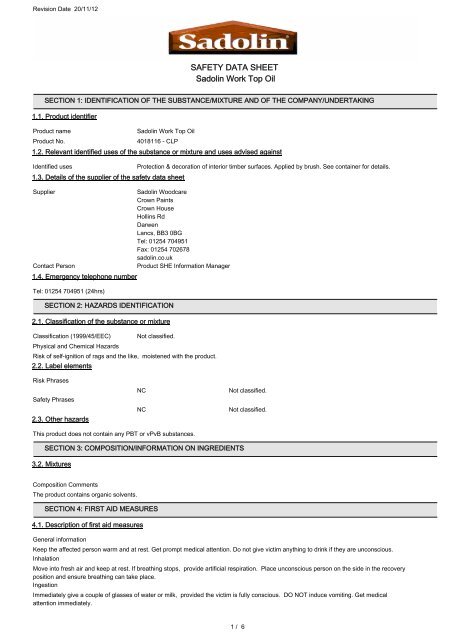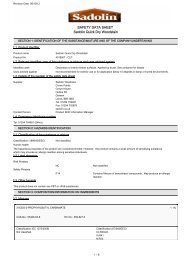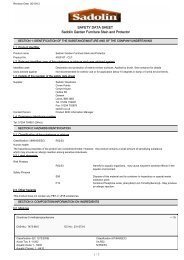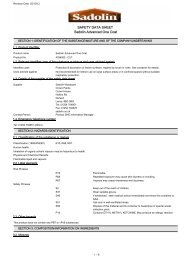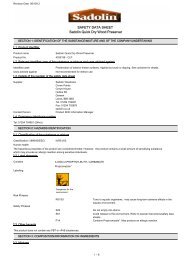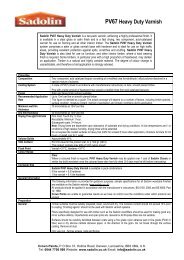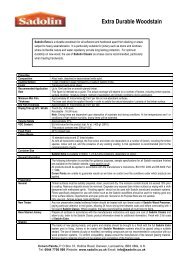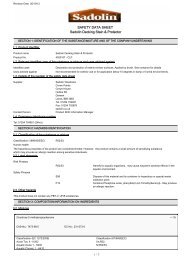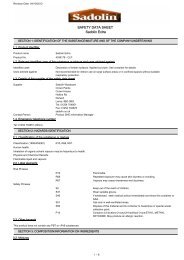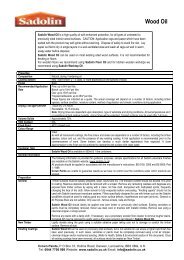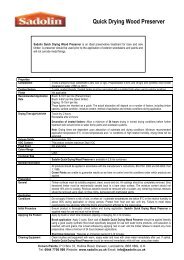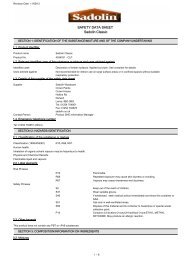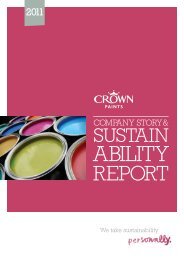SAFETY DATA SHEET Sadolin Work Top Oil
SAFETY DATA SHEET Sadolin Work Top Oil
SAFETY DATA SHEET Sadolin Work Top Oil
Create successful ePaper yourself
Turn your PDF publications into a flip-book with our unique Google optimized e-Paper software.
Revision Date 20/11/12<br />
<strong>SAFETY</strong> <strong>DATA</strong> <strong>SHEET</strong><br />
<strong>Sadolin</strong> <strong>Work</strong> <strong>Top</strong> <strong>Oil</strong><br />
SECTION 1: IDENTIFICATION OF THE SUBSTANCE/MIXTURE AND OF THE COMPANY/UNDERTAKING<br />
1.1. Product identifier<br />
Product name <strong>Sadolin</strong> <strong>Work</strong> <strong>Top</strong> <strong>Oil</strong><br />
Product No. 4018116 - CLP<br />
1.2. Relevant identified uses of the substance or mixture and uses advised against<br />
Identified uses Protection & decoration of interior timber surfaces. Applied by brush. See container for details.<br />
1.3. Details of the supplier of the safety data sheet<br />
Supplier<br />
<strong>Sadolin</strong> Woodcare<br />
Crown Paints<br />
Crown House<br />
Hollins Rd<br />
Darwen<br />
Lancs, BB3 0BG<br />
Tel: 01254 704951<br />
Fax: 01254 702678<br />
sadolin.co.uk<br />
Contact Person Product SHE Information Manager<br />
1.4. Emergency telephone number<br />
Tel: 01254 704951 (24hrs)<br />
SECTION 2: HAZARDS IDENTIFICATION<br />
2.1. Classification of the substance or mixture<br />
Classification (1999/45/EEC) Not classified.<br />
Physical and Chemical Hazards<br />
Risk of self-ignition of rags and the like, moistened with the product.<br />
2.2. Label elements<br />
Risk Phrases<br />
Safety Phrases<br />
2.3. Other hazards<br />
This product does not contain any PBT or vPvB substances.<br />
NC Not classified.<br />
NC Not classified.<br />
SECTION 3: COMPOSITION/INFORMATION ON INGREDIENTS<br />
3.2. Mixtures<br />
Composition Comments<br />
The product contains organic solvents.<br />
SECTION 4: FIRST AID MEASURES<br />
4.1. Description of first aid measures<br />
General information<br />
Keep the affected person warm and at rest. Get prompt medical attention. Do not give victim anything to drink if they are unconscious.<br />
Inhalation<br />
Move into fresh air and keep at rest. If breathing stops, provide artificial respiration. Place unconscious person on the side in the recovery<br />
position and ensure breathing can take place.<br />
Ingestion<br />
Immediately give a couple of glasses of water or milk, provided the victim is fully conscious. DO NOT induce vomiting. Get medical<br />
attention immediately.<br />
1 /<br />
6
Skin contact<br />
<strong>Sadolin</strong> <strong>Work</strong> <strong>Top</strong> <strong>Oil</strong><br />
Remove contaminated clothing immediately and wash skin with soap and water.<br />
Eye contact<br />
Immediately flush with plenty of water for up to 15 minutes. Remove any contact lenses and open eyes wide apart. Contact physician if<br />
irritation persists.<br />
4.2. Most important symptoms and effects, both acute and delayed<br />
General information<br />
The severity of the symptoms described will vary dependant of the concentration and the length of exposure.<br />
Inhalation.<br />
Vapours may cause headache, fatigue, dizziness and nausea.<br />
Ingestion<br />
May cause discomfort if swallowed. Nausea, vomiting. Diarrhoea.<br />
Skin contact<br />
Prolonged contact may cause redness, irritation and dry skin.<br />
Eye contact<br />
Irritation of eyes and mucous membranes.<br />
4.3. Indication of any immediate medical attention and special treatment needed<br />
Treat Symptomatically.<br />
SECTION 5: FIREFIGHTING MEASURES<br />
5.1. Extinguishing media<br />
Extinguishing media<br />
Extinguish with alcohol-resistant foam, carbon dioxide, dry powder or water fog.<br />
Unsuitable extinguishing media<br />
Do not use water jet as an extinguisher, as this will spread the fire.<br />
5.2. Special hazards arising from the substance or mixture<br />
Hazardous combustion products<br />
Thermal decomposition or combustion may liberate carbon oxides and other toxic gases or vapours.<br />
Unusual Fire & Explosion Hazards<br />
No unusual fire or explosion hazards noted.<br />
Specific hazards<br />
Fire creates: Toxic gases/vapours/fumes of: Carbon monoxide (CO). Carbon dioxide (CO2). Nitrous gases (NOx).<br />
5.3. Advice for firefighters<br />
Special Fire Fighting Procedures<br />
Keep up-wind to avoid fumes. Cool containers exposed to flames with water until well after the fire is out. Keep run-off water out of sewers<br />
and water sources. Dike for water control.<br />
Protective equipment for fire-fighters<br />
Self contained breathing apparatus and full protective clothing must be worn in case of fire.<br />
SECTION 6: ACCIDENTAL RELEASE MEASURES<br />
6.1. Personal precautions, protective equipment and emergency procedures<br />
Wear protective clothing as described in Section 8 of this safety data sheet. Ensure suitable personal protection (including respiratory<br />
protection) during removal of spillages in a confined area. Take precautionary measures against static discharges. Do not smoke, use<br />
open fire or other sources of ignition. Do not breathe vapour. Eye contact MUST be prevented by means of suitable personal protection<br />
equipment.<br />
6.2. Environmental precautions<br />
Do not discharge onto the ground or into water courses. Do not allow ANY environmental contamination. Spillages or uncontrolled<br />
discharges into watercourses must be IMMEDIATELY alerted to the Environmental Agency or other appropriate regulatory body.<br />
6.3. Methods and material for containment and cleaning up<br />
If leakage cannot be stopped, evacuate area. Clean-up personnel should use respiratory and/or liquid contact protection. Wash<br />
thoroughly after dealing with a spillage. Extinguish all ignition sources. Avoid sparks, flames, heat and smoking. Ventilate. Absorb spillage<br />
with non-combustible, absorbent material. Transfer to a container for disposal. Flush area with plenty of water.<br />
6.4. Reference to other sections<br />
For personal protection, see section 8. For waste disposal, see section 13.<br />
SECTION 7: HANDLING AND STORAGE<br />
7.1. Precautions for safe handling<br />
2 /<br />
6
<strong>Sadolin</strong> <strong>Work</strong> <strong>Top</strong> <strong>Oil</strong><br />
Keep away from heat, sparks and open flame. Eliminate all sources of ignition. Avoid contact with skin and eyes. Static electricity and<br />
formation of sparks must be prevented. Good personal hygiene is necessary. Wash hands and contaminated areas with water and soap<br />
before leaving the work site. Do not eat, drink or smoke when using the product. Observe good chemical hygiene practices. Do not use in<br />
confined spaces without adequate ventilation and/or respirator. Provide good ventilation. Container must be kept tightly closed.<br />
7.2. Conditions for safe storage, including any incompatibilities<br />
Keep away from heat, sparks and open flame. Keep containers tightly closed. Keep away from food, drink and animal feeding stuffs.<br />
Flammable/combustible - Keep away from oxidisers, heat and flames. Keep in original container. Store away from: Acids. Alkalis.<br />
Storage Class<br />
Unspecified storage.<br />
7.3. Specific end use(s)<br />
SECTION 8: EXPOSURE CONTROLS/PERSONAL PROTECTION<br />
8.1. Control parameters<br />
Ingredient Comments<br />
WEL = <strong>Work</strong>place Exposure Limits<br />
8.2. Exposure controls<br />
Protective equipment<br />
Process conditions<br />
Provide eyewash, quick drench.<br />
Engineering measures<br />
Provide adequate ventilation, including appropriate local extraction, to ensure that the defined occupational exposure limit is not<br />
exceeded.<br />
Respiratory equipment<br />
If ventilation is insufficient, suitable respiratory protection must be provided. At work in confined or poorly ventilated spaces, respiratory<br />
protection with air supply must be used. Check that mask fits tight and change filter regularly.<br />
Hand protection<br />
Protective gloves must be used if there is a risk of direct contact or splash. Gloves of nitrile rubber, PVA or Viton are recommended.<br />
Eye protection<br />
Wear approved chemical safety goggles where eye exposure is reasonably probable.<br />
Other Protection<br />
Wear appropriate clothing to prevent any possibility of skin contact. Provide eyewash station.<br />
Hygiene measures<br />
Wash hands at the end of each work shift and before eating, smoking and using the toilet.<br />
Skin protection<br />
Wear apron or protective clothing in case of splashes.<br />
SECTION 9: PHYSICAL AND CHEMICAL PROPERTIES<br />
9.1. Information on basic physical and chemical properties<br />
Appearance Clear liquid.<br />
Colour Colourless.<br />
Odour Characteristic. Hydrocarbon.<br />
Solubility Immiscible with water<br />
Initial boiling point and boiling range >280<br />
Relative density 853 @ 15°C<br />
Bulk Density<br />
Not known.<br />
Vapour density (air=1) >1<br />
Vapour pressure 320<br />
Flammability Limit - Lower(%) 1<br />
3 /<br />
6
Flammability Limit - Upper(%) 10<br />
9.2. Other information<br />
SECTION 10: STABILITY AND REACTIVITY<br />
10.1. Reactivity<br />
There are no known reactivity hazards associated with this product.<br />
10.2. Chemical stability<br />
Stable under normal temperature conditions and recommended use.<br />
10.3. Possibility of hazardous reactions<br />
Not determined.<br />
10.4. Conditions to avoid<br />
Avoid frost. Avoid heat.<br />
10.5. Incompatible materials<br />
Materials To Avoid<br />
Strong oxidising substances. Strong acids. Strong alkalis.<br />
10.6. Hazardous decomposition products<br />
<strong>Sadolin</strong> <strong>Work</strong> <strong>Top</strong> <strong>Oil</strong><br />
None at ambient temperatures. Thermal decomposition or combustion may liberate carbon oxides and other toxic gases or vapours.<br />
SECTION 11: TOXICOLOGICAL INFORMATION<br />
11.1. Information on toxicological effects<br />
General information<br />
Contains small amounts of organic solvents. Extensive use of the product in areas with inadequate ventilation may result in hazardous<br />
vapour concentrations.<br />
Inhalation<br />
When working extensively on big surfaces in small and badly ventilated rooms, vapours may develop in concentrations which may cause<br />
malaise such as headache, dizziness and nausea.<br />
Ingestion<br />
Nausea, vomiting. Headache. Diarrhoea.<br />
Skin contact<br />
May cause defatting of the skin, but is not an irritant. Repeated exposure may cause skin dryness or cracking. The product contains a<br />
small amount of sensitising substance which may provoke an allergic reaction among sensitive individuals after repeated contact.<br />
Eye contact<br />
May cause temporary eye irritation.<br />
SECTION 12: ECOLOGICAL INFORMATION<br />
Ecotoxicity<br />
There are no data on the ecotoxicity of this product. The product is not expected to be hazardous to the environment. The product contains<br />
substances which are toxic to aquatic organisms and which may cause long term adverse effects in the aquatic environment.<br />
12.1. Toxicity<br />
Do not allow to enter drains, sewers or watercourses.<br />
12.2. Persistence and degradability<br />
The product is not expected to be biodegradable.<br />
12.3. Bioaccumulative potential<br />
Bioaccumulative potential<br />
Bioaccumulation is unlikely to be significant because of the low water solubility of this product.<br />
12.4. Mobility in soil<br />
4 /<br />
6
Mobility:<br />
Not considered mobile.<br />
12.5. Results of PBT and vPvB assessment<br />
This product does not contain any PBT or vPvB substances.<br />
12.6. Other adverse effects<br />
Not determined.<br />
SECTION 13: DISPOSAL CONSIDERATIONS<br />
General information<br />
<strong>Sadolin</strong> <strong>Work</strong> <strong>Top</strong> <strong>Oil</strong><br />
Waste to be treated as controlled waste. Disposal to licensed waste disposal site in accordance with local Waste Disposal Authority.<br />
13.1. Waste treatment methods<br />
Do not allow runoff to sewer, waterway or ground. Dispose of waste and residues in accordance with local authority requirements.<br />
Waste Class<br />
Waste product 08 01 11 Used packaging containg only dried residues 15 01 02<br />
SECTION 14: TRANSPORT INFORMATION<br />
General The product is not covered by international regulation on the transport of dangerous goods (IMDG, IATA,<br />
ADR/RID).<br />
14.1. UN number<br />
14.2. UN proper shipping name<br />
14.3. Transport hazard class(es)<br />
ADR/RID/ADN Class Not classified for transportation.<br />
Transport Labels<br />
14.4. Packing group<br />
14.5. Environmental hazards<br />
Environmentally Hazardous Substance/Marine Pollutant<br />
No.<br />
14.6. Special precautions for user<br />
Tunnel Restriction Code None required<br />
No transport warning sign required.<br />
14.7. Transport in bulk according to Annex II of MARPOL73/78 and the IBC Code<br />
Not applicable.<br />
SECTION 15: REGULATORY INFORMATION<br />
15.1. Safety, health and environmental regulations/legislation specific for the substance or mixture<br />
Approved Code Of Practice<br />
Classification and Labelling of Substances and Preparations Dangerous for Supply. Safety Data Sheets for Substances and Preparations.<br />
Guidance Notes<br />
<strong>Work</strong>place Exposure Limits EH40.<br />
EU Legislation<br />
Dangerous Substance Directive 67/548/EEC. Dangerous Preparations Directive 1999/45/EC. Regulation (EC) No 1907/2006 of the<br />
European Parliament and of the Council of 18 December 2006 concerning the Registration, Evaluation, Authorisation and Restriction of<br />
Chemicals (REACH), establishing a European Chemicals Agency, amending Directive 1999/45/EC and repealing Council Regulation<br />
(EEC) No 793/93 and Commission Regulation (EC) No 1488/94 as well as Council Directive 76/769/EEC and Commission Directives<br />
91/155/EEC, 93/67/EEC, 93/105/EC and 2000/21/EC, including amendments. Classification, labelling and packaging of substances and<br />
mixtures 1272/2008EC<br />
National Regulations<br />
The Chemicals (Hazard Information and Packaging) for supply regulations (as amended)<br />
5 /<br />
6
15.2. Chemical Safety Assessment<br />
No chemical safety assessment has been carried out.<br />
SECTION 16: OTHER INFORMATION<br />
Issued By HS&E Manager.<br />
Revision Date 20/11/12<br />
SDS No. Revision 5<br />
<strong>Sadolin</strong> <strong>Work</strong> <strong>Top</strong> <strong>Oil</strong><br />
Disclaimer<br />
This information relates only to the specific material designated and may not be valid for such material used in combination with any other materials or in<br />
any process. Such information is, to the best of the company's knowledge and belief, accurate and reliable as of the date indicated. However, no<br />
warranty guarantee or representation is made to its accuracy, reliability or completeness. It is the user's responsibility to satisfy himself as to the<br />
suitability of such information for his own particular use.<br />
6 /<br />
6


